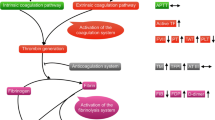Summary
Platelet activating factor (PAF) content and PAF-acetylhydrolase (PAFAH) activity were measured in the plasma and haematoma of 34 chronic subdural haematoma (CSH) patients. The plasma PAF level in patients with CSH was higher than that in healthy controls. Although there was no correlation between the plasma PAF levels and the interval between the onset of symptoms and the day of sampling, namely, the interval after bleeding, the haematoma PAF level gradually decreased according to the interval after the onset of symptoms. There was no difference between plasma PAFAH activity in patients with CSH and that in healthy controls, and haematoma enzyme activity gradually increased correlated with the interval between the onset of symptoms and surgery. In addition, the localization of PAF in haematoma capsules was histochemically determined. PAF was solely localized to the peri-sinusoidal vessels in the outer membrane of haematoma capsules. Based on these biochemical and histochemical studies, we speculated that PAF may play a role in the development of chronic subdural haematomas.
Similar content being viewed by others

References
Bergstrom M, Ericson K, Levander B,et al (1977) Computed tomography of cranial subdural and epidural hematomas: variation of attenuation related to time and clinical events such as rebleeding. J Comput Assist Tomogr 1: 445–449
Bjork J, Lindbrom L, Gerdin B,et al (1983) PAF-acether (platelet-activating factor) increases microvascular permeability and affects endothelium-granulocyte interaction in microvascular beds. Acta Physiol Scand 119: 305–308
Blank ML, Hall MN, Cress EA,et al (1983) Inactivation of 1-alkyl-2-acetyl-sn-glycero-3-phosphocholine by a plasma acetylhydrolase: higher activities in hypertensive rats. Biochem Biophys Res Commun 113: 666–671
Bligh EG, Dyer WT (1959) A rapid method of total lipid extraction and purification. Can J Biochem Physiol 37: 911–917
Bradford MM (1981) A rapid sensitive method for the quantitation of microgram quantities of protein utilizing the principle of protein dye-binding. Anal Biochem 72: 248–254
Camussi G, Aglietta M, Coda R,et al (1981) Release of plateletactivating factor (PAF) and histamine. II. The cellular origin of human PAF: monocytes, polymorphonuclear neutrophils and basophils. Immunology 42: 191–199
Chap H, Mauco G, Simon MF,et al (1981) Biosynthetic labelling of platelet activating factor from radioactive acetate by stimulated platelets. Nature 289: 312–314
Fujisawa H, Ito H, Saito K,et al (1991) Immunohistochemical localization of tissue-type plasminogen activator in the lining wall of chronic subdural hematoma. Surg Neurol 35: 441–445
Hanahan DJ, Weintraub ST (1985) Platelet-activating factor. Isolation, identification and assay. In: Glick D (ed) Methods of biochemical analysis. Wiley, New York, pp 195–219
Hayashi M, Kimura J, Yamaki K,et al (1987) Detection of platelet-activating factor in exudates of rats with phorbol myristate acetate-induced pleurisy. Thromb Res 48: 299–310
Hirashima Y, Kato R, Endo S,et al (1993) Immunofluorescent localization of platelet-activating factor (PAF) in the rat. Histochemical J 25: 830–833
Hirashima Y, Endo S, Ohmori T (1994) Platelet-activating factor (PAF) concentration and PAF acetylhydrolase activity in cerebrospinal fluid of patients with subarachnoid hemorrhage. J Neurosurg 80: 31–36
Ito H, Yamamoto S, Komai T,et al (1976) Role of local hyperfibrinolysis in the etiology of chronic subdural hematoma. J Neurosurg 45: 26–31
Karasawa K, Satoh N, Masuda M,et al (1991) Antibodies to synthetic platelet-activating factor (1-O-alkyl-2-O-acetyl-sn-glycero-3-phosphocholine) analogues with substituents at thesn-2 position. J Biochem 110: 683–687
Kroegel C, Yukawa T, Dent G,et al (1988) Platelet-activating factor induces eosinophil peroxidase release from purified human eosinophils. Immunology 64: 559–562
Labadle EL, Glover D (1976) Physiopathogenesis of subdural hematomas. Part 1: histological and biochemical comparisons of subcutaneous hematoma in rats with subdural hematoma in man. J Neurosurg 45: 382–392
Lee TG, Lenihan DJ, Malone B,et al (1984) Increased biosynthesis of platelet-activating factor in activated human eosinophils. J Biol Chem 259: 5526–5530
Miwa M, Miyake T, Yamanaka T,et al (1988) Characterization of sreum platelet-activating factor (PAF) acetylhydrolase. Correlation between deficiency of serum PAF acetylhydrolase and respiratory symptoms in asthmatic children. J Clin Invest 82: 1983–1991
Ono S, Tamakuma S, Mochizuki H,et al (1993) Clinical and experimental studies on the role of platelet-activating factor (PAF) in the pathogenesis of septic DIC. Surgery Today 23: 228–233
Prescott SM, Zimmerman GA, McIntyre TM (1984) Human endotelial cells in culture produce platelet-activating factor (1-alkyl-2-acetyl-sn-glycero-3-phosphocholine) when stimulated with thrombin. Proc Natl Acad Sci USA 81: 3534–3538
Rosengren S, Bjork J, Smedegard G (1988) Oxygen radicals are not a prerequisite for neutrophil-mediated increased vascular permeability, Lab Invest 58: 559–564
Shaw JO, Pinckard RN, Ferrigni KS,et al (1981) Activation of human neutrophils with 1-O-hexadecyl/octadecyl-2-acetyl-sn-glyceryl-3-phosphorylcholine(platelet activating factor). J Immunol 127: 1250–1255
Tamura N, Agrawal DK, Suliaman FA,et al (1987) Effects of platelet activating factor on the chemotaxis of normodense eosinophils from normal subjects. Biochem Biophys Res Commun 142: 638–644
Wardlaw AJ, Mogbel R, Cromwell O,et al (1986) Platelet-activating factor. A potent chemotactic and chemokinetic factor for human eosinophils. J Clin Invest 78: 1701–1706
Yamashima T, Kubota T, Yamamoto S (1985) Eosinophil degranulation in the capsule of chronic subdural hematomas. J Neurosurg 62: 257–260
Author information
Authors and Affiliations
Rights and permissions
About this article
Cite this article
Hirasima, Y., Endo, S., Kato, R. et al. Platelet-activating factor (PAF) and the development of chronic subdural haematoma. Acta neurochir 129, 20–25 (1994). https://doi.org/10.1007/BF01400868
Issue Date:
DOI: https://doi.org/10.1007/BF01400868



